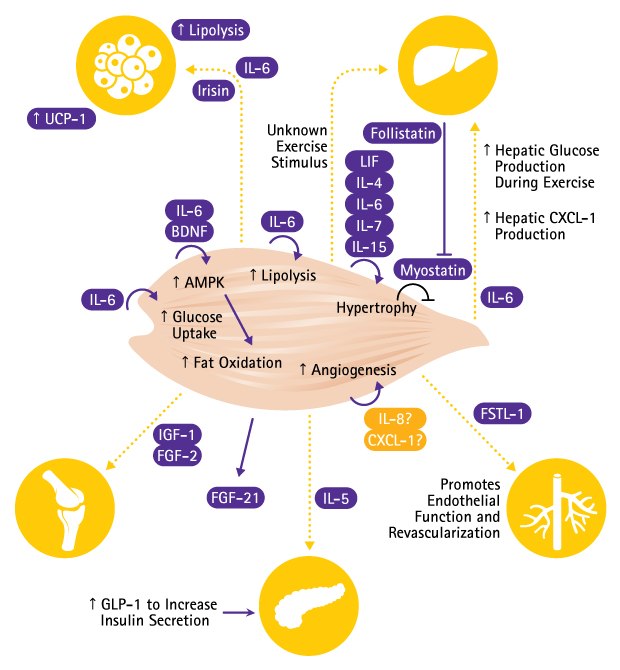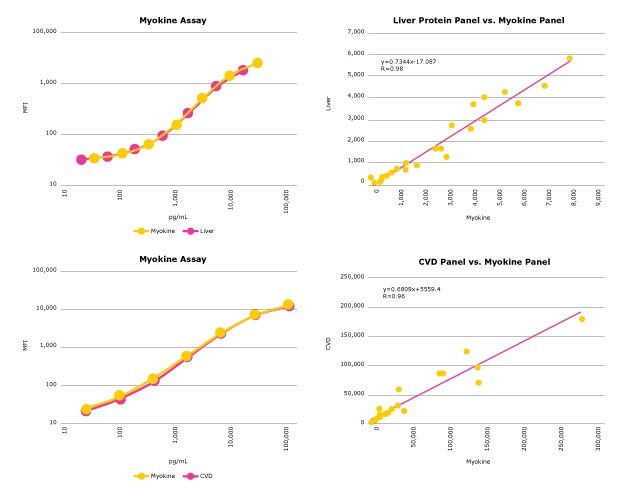Multiplexed Myokine Analysis: Simultaneously Measure Multiple Muscle-Secreted Factors
Section Overview
- What Are Myokines?
- Myokine Multiplex Analysis
- Methods
- Multiplex Results
- Summary
- Related Products
- References
The diverse systems of myokines are involved in various signaling pathways. Multiplex myokine immunoassays, such as the MILLIPLEX® Human Myokine Panel, allow researchers to simultaneously measure multiple muscle-secreted factors, providing more insights into related diseases.
What Are Myokines?
Skeletal muscle is actively involved in the synthesis and secretion of many proteins collectively termed "myokines". 1 Myokines can act in autocrine and/or paracrine manners to regulate skeletal muscle metabolism, muscle proliferation, and muscle differentiation (muscle growth), as shown in Figure 1.

Figure 1. Myokines, secreted by skeletal muscle, signal to diverse organs, including the liver, pancreas, bone, and circulatory system. The precise mechanisms by which angiogenesis is upregulated are still being studied. Adapted from Pedersen BK, Febbraio MA. Muscles, exercise and obesity: skeletal muscle as a secretory organ. Nat Rev Endocrinol. 2012 Apr 3; 8(8): 457 – 65. 1
Myokines can also act as endocrine hormones in altering cell metabolism, endothelial function, and tumor growth/retardation. These myokines are also involved in inflammatory responses in a wide variety of tissues, including the heart, adipose tissue, breast, colon, liver, intestine, endothelium, bone, and skeletal muscle. Emerging evidence supports the fact that the anti-inflammatory, disease-fighting effects of exercise may be mediated by these myokines, and that myokine signaling pathways intersect with innate immunity, neurological signaling, and insulin response.2,3
Additionally, the progressive loss of skeletal muscle function and mass, sarcopenia, is a serious feature of senescence, or aging, and a key component of geriatric syndromes which include functional decline and delirium. Growing evidence suggests that muscle-derived growth factors and cytokines, aka myokines, modulate the progression of age-related diseases and contribute to the inter-tissue communication that underlies systemic aging.
Myokine Multiplex Analysis
The increasing requirement to quantify myokines in preclinical and translational research models has created the need for multiplex immunoassays in this research. Multiplex analysis of myokines allows researchers to simultaneously measure multiple myokines. For example, the MILLIPLEX® Human Myokine Panel is a 15-plex kit designed for the simultaneous quantification of any or all of the following analytes in serum or plasma samples, which have the indicated biological functions described in Table 1.
Table 1. Analytes in the MILLIPLEX® Human Myokine Panel and their biological functions.
Methods
Multiplex assays using the standards included in the assay kit, as well as serum and plasma samples, were conducted using the MILLIPLEX® Human Myokine Magnetic Bead Panel, following the instructions in the included protocol. Capture antibody-coated beads were incubated with samples to immobilize the analyte. The biotinylated detection antibody was added. This detection antibody binds to the analyte to form a sandwich. Streptavidin-phycoerythrin (SA-PE) dye was added so it could bind to the sandwich and emit fluorescent light.
Multiplex Results
Using standards for each analyte serially diluted in serum matrix, standard curves were prepared to determine the assay response (measured in Mean Fluorescence Intensity [MFI] with respect to analyte concentration). The standard curves established that the assay generated linear MFI response over 3 to 5 orders of magnitude for all analytes (Figure 2).

Figure 2. Using standards for each analyte serially diluted in the validated serum matrix, standard curves were prepared to determine the assay response with respect to the analyte concentration. The standard curves established the linearity of the assay over three to four orders of magnitude for all analytes. The concentrations of analyte were measured in MFI.
Cross-Reactivity
No significant cross-reactivity was seen within the panel. Most of the antibodies in this human myokine panel can recognize monkey samples, except Fractalkine, LIF, and IL-6. The following cross-reactivity was found:
- Apelin cross-reacts with mouse, dog, rabbit, and minipig.
- BDNF cross-reacts with mouse and rabbit.
- EPO cross-reacts with dog and rabbit.
- IL-15 cross-reacts with horse.
- Myostatin cross-reacts with dog, minipig, and horse.
- FABP3 cross-reacts with rat, rabbit, minipig, and horse.
- FSTL1 cross-reacts with mouse, rabbit, minipig, and horse.
- OSM cross-reacts with dog and minipig.
- FGF-21 cross-reacts with dog, minipig, and horse.
Note that only a limited amount of normal samples were tested in this study, and we could not rule out the possible cross-reactivity in other normal or disease samples.
Spike Recovery
Known amounts of each analyte (points 3, 4, 5 on the standard curves) were spiked into normal human serum/plasma samples. Percent recovery was calculated using the following equation:
Calculated concentration of analyte / Expected concentration *100
Recovery of all spiked samples was between 70% and 130%.
Consistency and Accuracy with Other Multiplex Panels
To test the consistency and accuracy between MILLIPLEX® assays, we compared the quantitation of analytes existing in both this human myokine panel and other MILLIPLEX® panels. All the standard curves showed an overlapping response and analyte concentrations calculated in biological samples correlated very well.
For example, FGF-21 and FABP3 sample values were measured using both the MILLIPLEX® Human Myokine Panel, and the MILLIPLEX® Human Liver Protein and Human CVD1 Panels. Standard curves were created using standards of purified FGF-21. FABP3 from two panels showed overlapping assay response and linear range of the assays. Assay correlation was excellent, with the slope and R-value approaching unity (Figure 3).

Figure 3. Comparison of the MILLIPLEX® Human Myokine Panel with the MILLIPLEX® Liver Panel and MILLIPLEX®CVD Panel for the measurement of FGF-21 (top) and FABP3 (bottom) respectively.
In addition to FGF-21 and FABP3, we have compared the same analytes in this human myokine panel with other MILLIPLEX® panels. All the standard curves showed overlapping responses and analyte concentrations that correlated very well with biological samples (data not shown).
Normal vs. Sepsis Samples
Finally, biological qualification of the assay panel was performed using serum/plasma samples from healthy subjects and from those with sepsis. As expected, 15 novel myokines were simultaneously quantified by the assay. FABP3, Irisin, FSTL1, OSM, IL-6, FGF-21, and Musclin were significantly upregulated in sepsis samples (Table 2).
Normal Sample Summary Data [pg/mL]
Sepsis Sample Summary Data [pg/mL]
Table 2. Comparison of biomarkers expressed in normal and sepsis serum/plasma samples. FABP3, Irisin, FSTL1, OSM, IL-6, FGF-21, and Musclin were shown to be upregulated in sepsis samples. *Not assayed.
Summary
The MILLIPLEX® Human Myokine Panel is sensitive, accurate, and reproducible. The sample values generated with this new panel are consistent with previous panels that include some of the same analytes. This panel provides an ideal immunoassay for diverse research areas, including metabolic, neuromuscular, and idiopathic myopathy diseases.
Myokine Assays
Aging Assays
For Research Use Only. Not For Use In Diagnostic Procedures.
References
如要继续阅读,请登录或创建帐户。
暂无帐户?